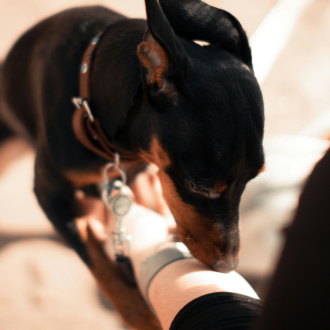There is lots of misinformation online about cancer and whether animals can detect it in the human body. Today, we’ll answer that question.
Rosannah from Sydney asked:
“Is it true that animals can be trained to smell cancer? I have read stories of pets detecting cancer in their owners."
Studies suggest that dogs could be trained to sniff out cancer.
There is growing interest in the possibility that dogs, because of their incredible sense of smell, might be able to “smell” cancer. The hypothesis was first raised in 1989 when doctors described a case of a woman concerned about a mole that her dog would constantly sniff at, and had tried to bite, which turned out to be a malignant melanoma. There have been several other reports since then of dogs detecting cancers by constantly sniffing or nudging an area of their owner’s body.
Tumours produce volatile organic compounds which are released into urine and sweat and exhaled in breath. Even in small quantities these compounds are thought to have a distinct odour, particularly in the early stages of cancer when cells are dividing. Several studies have shown that animals may detect differences in body odours between healthy people and cancer patients, especially for lung, breast and prostate cancers.
Studies over the past decade have shown trained dogs could identify the urine of patients with bladder cancer almost three times more often than would be expected by chance alone, detect lung cancer in exhaled breath samples with very high accuracy (in two separate studies) and identify ovarian and colorectal cancers by smelling breath samples.
The use of several species of animal to detect scents also seems promising, with success rates above 80% for most. A large variety of animals, including dogs, rodents, insects and roundworms, have been used for this purpose and have all shown their capacity to detect cancer. This research primarily involves animals being presented with different sources of stimuli, such as urine, to see if they can distinguish the odours of people affected by cancer.
Scientists are also using chemical analysis and nanotechnology to try to identify cancer biomarkers in breath, sweat and urine that could be used in blood tests or other tests to detect cancer. If they can identify the chemical changes responsible for the odour the dogs are picking up, it may be possible to develop computerised screening instruments with the same sensitivity dogs have.
Currently, the matter remains a subject of research rather than procedure.
iHeard hub
Thank you for joining the mission against misinformation
If you’ve heard a rumour about cancer, or are unsure about information you’ve read online, ask your own cancer question via the iHeard hub.
We want everyone to have the correct information about cancer so if you know anyone else with a cancer question, why not let them know about iHeard?
This article was last updated 24/01/2024.

